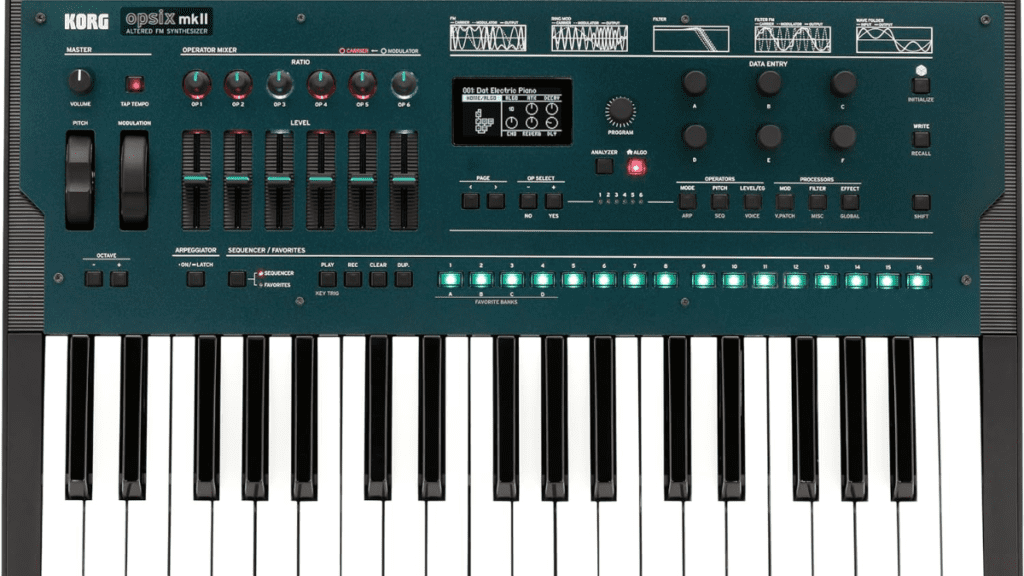Exploring the Korg Opsix MKII: Features, Sound Quality, and Performance

A Modern Take on Classic FM Synthesis
Korg has been a leader in synthesizer innovation for decades, consistently pushing the boundaries of sound design. The Korg Opsix MKII is the latest in a line of groundbreaking instruments, offering a fresh approach to FM synthesis. Building on the success of the original Opsix, this new iteration provides enhanced features, improved sound quality, and even greater creative potential for musicians and producers alike.
Overview:
The Korg Opsix MKII is a digital synthesizer that reimagines the complexities of FM synthesis, making it more accessible and musically versatile. It combines the iconic sound characteristics of traditional FM synthesis with modern digital enhancements, offering a user-friendly interface and a host of new features that expand its sonic palette. The Opsix MKII is designed for both experienced sound designers and newcomers looking to explore the depths of FM synthesis without being overwhelmed by its intricacies.
Sound Engine:
At the heart of the Opsix MKII is its advanced FM sound engine, which allows for deep and complex sound creation. Unlike traditional FM synthesizers that often have a steep learning curve, the Opsix MKII offers a more intuitive approach, with six operators that can be easily modified using its streamlined interface. The sound engine is capable of generating a wide range of tones, from classic FM bell-like sounds and electric pianos to entirely new textures that push the boundaries of what’s possible with FM synthesis.
Oscillators and Waveforms:
The Opsix MKII features six oscillators, or operators, each with its own set of waveforms. These can be combined in various ways, using different algorithms, to create complex sounds. In addition to traditional sine waves, the Opsix MKII includes a variety of other waveforms, providing even more flexibility in sound design. The synthesizer also allows for easy waveform editing, enabling users to fine-tune their sounds with precision.
Filters and Modulation:
Korg has enhanced the filter section of the Opsix MKII, adding more filter types and improving their quality. The filters include low-pass, high-pass, band-pass, and more, allowing users to sculpt their sounds with accuracy. The modulation options are extensive, with multiple LFOs and envelope generators that provide dynamic control over various parameters. This depth of modulation opens up a wide range of creative possibilities, making it easier to achieve evolving and expressive sounds.
Effects Processing:
The Opsix MKII comes equipped with a robust effects section that includes reverb, delay, chorus, and a variety of other effects. These are designed to complement the FM synthesis engine, adding depth and dimension to the sounds. The effects can be easily applied and adjusted in real-time, making them a valuable tool for both live performance and studio production.
Polyphony and Voice Modes:
With 32-voice polyphony, the Opsix MKII offers ample headroom for creating rich, layered sounds. This is particularly important in FM synthesis, where complex sounds often require multiple voices to be fully realized. The synthesizer supports multiple voice modes, including monophonic, polyphonic, and unison, allowing for a wide range of performance options.
Keyboard and Controls:
The Opsix MKII features a 37-key velocity-sensitive keyboard with aftertouch, providing a responsive and expressive playing experience. The control interface is well-designed, with a clear layout that makes it easy to navigate the various parameters. The inclusion of physical knobs and sliders allows for hands-on control, making sound design more intuitive and immediate.
Sequencing and Arpeggiation:
The built-in sequencer and arpeggiator are powerful tools for creating rhythmic patterns and melodic sequences. The sequencer is straightforward to use, with a step-based interface that allows for quick and easy creation of sequences. The arpeggiator offers various modes and patterns, adding another layer of creative potential to the instrument.
Build Quality and Durability:
Korg has maintained a high standard of build quality with the Opsix MKII, using durable materials and solid construction. The synthesizer is designed to withstand the demands of both studio use and live performance, making it a reliable choice for professional musicians. The overall design is sleek and modern, reflecting the instrument’s advanced capabilities.
Connectivity and Power Base:

The Opsix MKII offers a comprehensive set of connectivity options, including MIDI, USB, and audio inputs and outputs. These connections make it easy to integrate the synthesizer into any studio setup or live rig. The inclusion of both 5-pin MIDI and USB-MIDI allows for flexible control options, while the audio outputs ensure high-quality sound reproduction. The Opsix MKII is also designed to be power-efficient, making it a practical choice for on-the-go musicians.
Pros:
- Intuitive approach to FM synthesis with a user-friendly interface.
- Versatile sound engine capable of both classic and modern tones.
- Extensive modulation and effects options.
- High-quality build and responsive keyboard with aftertouch.
- Comprehensive connectivity options.
Cons:
- Learning curve for those new to FM synthesis, despite its more accessible design.
- Limited to 37 keys, which might be a constraint for some performers.
Conclusion:
The Korg Opsix MKII is a standout instrument that brings the power of FM synthesis into a more approachable and versatile form. With its advanced sound engine, extensive modulation capabilities, and high-quality effects, it offers a wealth of creative possibilities for musicians and producers. While there is still a learning curve for those new to FM synthesis, the Opsix MKII’s intuitive design and user-friendly interface make it an excellent choice for anyone looking to explore this powerful synthesis method. Its robust build quality and comprehensive connectivity options further enhance its appeal, making it a worthy addition to any studio or live setup.
